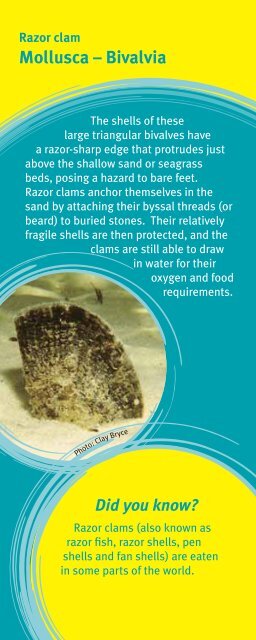Beachcombers Field Guide - Department Of Fisheries Western ...
Beachcombers Field Guide - Department Of Fisheries Western ... Beachcombers Field Guide - Department Of Fisheries Western ...
Razor clam Mollusca – Bivalvia The shells of these large triangular bivalves have a razor-sharp edge that protrudes just above the shallow sand or seagrass beds, posing a hazard to bare feet. Razor clams anchor themselves in the sand by attaching their byssal threads (or beard) to buried stones. Their relatively fragile shells are then protected, and the clams are still able to draw in water for their oxygen and food requirements. Did you know? Razor clams (also known as razor fi sh, razor shells, pen shells and fan shells) are eaten in some parts of the world.
Sea jelly
- Page 5 and 6: Photo: Cottesloe Coastcare Globefi
- Page 7 and 8: Photo: Sandy Clarke Weeping toadfis
- Page 9 and 10: Photo: Gilbert Stokman Shaw’s cow
- Page 11 and 12: Photo: Sandy Clarke Common seadrago
- Page 13 and 14: Photo: Sandy Clarke West Australian
- Page 15 and 16: Photo: Michelle Dyer Sea squirt
- Page 17 and 18: Sea tulip Photo: Michelle Dyer
- Page 19 and 20: Photo: Michelle Dyer Colonial ascid
- Page 21 and 22: Sponge Photo: Sandy Clarke
- Page 23 and 24: Photo: Michelle Dyer Bryozoan
- Page 25 and 26: Photo: Michelle Dyer Violet snail
- Page 27 and 28: Photo: Michelle Dyer Turban snail
- Page 29 and 30: Photo: Sandy Clarke Cone shell
- Page 31 and 32: Photo: Sandy Clarke Baler shell
- Page 33 and 34: Limpet Photo: Michelle Dyer
- Page 35 and 36: Abalone Photo: Michelle Dyer
- Page 37 and 38: Sea hare Photo: Sandy Clarke
- Page 39 and 40: Photo: Sandy Clarke Cowry shell
- Page 41 and 42: Photo: Michelle Dyer Periwinkle
- Page 43 and 44: Photo: Michelle Dyer Cuttlebone
- Page 45 and 46: Photo: Sandy Clarke Ram’s horn sh
- Page 47 and 48: Chiton
- Page 49 and 50: Mussel
- Page 51 and 52: Scallop
- Page 53 and 54: Pipi
- Page 55: Razor clam
- Page 59 and 60: Bluebottle
- Page 61 and 62: Coral
- Page 63 and 64: Acorn barnacle
- Page 65 and 66: Goose barnacle
- Page 67 and 68: Crab
- Page 69 and 70: Tube worm
- Page 71 and 72: Sea urchin
- Page 73 and 74: Sea star
- Page 75 and 76: The piles of algae and seagrasses f
- Page 77 and 78: Green algae are characteristically
- Page 79 and 80: Found throughout southern Australia
- Page 81 and 82: Brown algae contain most of the lar
- Page 83 and 84: Found throughout Australian waters,
- Page 85 and 86: Red algae are the most numerous of
- Page 87 and 88: Common on rocky reefs, this red alg
- Page 89 and 90: Seagrasses are marine fl owering pl
- Page 91 and 92: Strapweed or Posidonia is the only
- Page 93 and 94: Along with strapweed, wireweed is o
- Page 95 and 96: This sausage jelly (as they are som
- Page 97 and 98: The catshark is a nocturnal shark,
- Page 99 and 100: The bobtail or bluetongue lizard is
- Page 101 and 102: Beaches provide an important haul-o
Razor clam<br />
Mollusca – Bivalvia<br />
The shells of these<br />
large triangular bivalves have<br />
a razor-sharp edge that protrudes just<br />
above the shallow sand or seagrass<br />
beds, posing a hazard to bare feet.<br />
Razor clams anchor themselves in the<br />
sand by attaching their byssal threads (or<br />
beard) to buried stones. Their relatively<br />
fragile shells are then protected, and the<br />
clams are still able to draw<br />
in water for their<br />
oxygen and food<br />
requirements.<br />
Did you know?<br />
Razor clams (also known as<br />
razor fi sh, razor shells, pen<br />
shells and fan shells) are eaten<br />
in some parts of the world.



